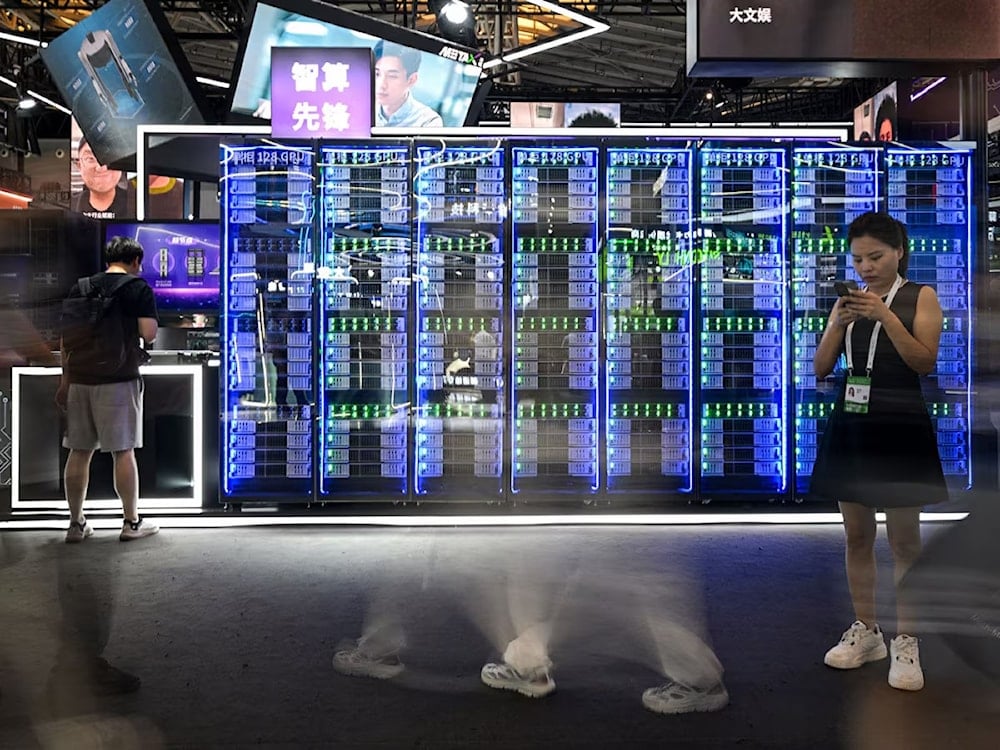Chinese tech continues to accelerate after DeepSeek’s AI breakthrough
Following the success of China's DeepSeek chatbot, Beijing continues to move forward with AI development with a focus on real-world applications
-

A long exposure shows people visiting the World Artificial Intelligence Conference at the Shanghai World Expo and Convention Center on July 28, 2025. (Hector Retamal/AFP)
In Liangzhu, a tranquil suburb of Hangzhou known for its archaeological legacy, Chinese technology is fast becoming the future. Once celebrated for ancient relics dating back to 3300 BC, Liangzhu is now home to a flourishing ecosystem of artificial intelligence startups and developers. It has also become a magnet for investors seeking the next frontier of artificial technology.
The area’s prominence surged six months ago when DeepSeek, a little-known AI startup, unveiled an open-source large language model (LLM) that rivaled Western counterparts but at a fraction of the cost. Its founder, an alumnus of Zhejiang University, triggered a shift that is still rippling through China’s technology scene.
According to an article by The Economist, since DeepSeek’s rise, three additional Chinese labs have released highly advanced language models. Analysts note that AI in China has now crossed “the critical threshold of usefulness,” fueling widespread interest in real-world applications. As one early-stage investor described it, “Once the water boils, many people want to build a steam engine.”
One of them is Sam Hu, a former employee at Tencent and ride-hailing firms, who now develops an AI agent designed to assist business managers. “The cost of trial and error is lower now,” Hu says from a café in Liangzhu’s central plaza.
The potential is enormous, The Economist said. Morgan Stanley projects that China’s artificial technology industry will surge from $3.2 billion in 2024 to $140 billion by 2030, and up to $1.4 trillion if related sectors are included. Generative AI usage among Greater China firms jumped from 8% to 43% in just under a year.
While some initial excitement has cooled and users still report “hallucinations” in AI outputs, DeepSeek’s impact remains transformative. The focus has shifted from intense competition over raw model development to scalable adoption across industries, education, government, and civil services.
State support powers China's push in artificial technology
The Chinese government shares the belief that the country’s strength lies in the adoption and diffusion of AI. Earlier this year, President Xi Jinping’s televised handshake with DeepSeek’s founder, Liang Wenfeng, captured national attention and inspired broader public interest. Even older generations began experimenting with chatbots.
Educators like Louis Dong responded to surging demand by launching AI-focused curricula for children. “Now the emphasis is on applying AI across specific sectors,” he says, according to The Economist. DeepSeek’s breakthrough, coupled with other domestic advances, is driving this transformation.
Despite challenges, such as chip restrictions from the US, Chinese technology continues to thrive. Although exports of advanced Nvidia chips were restricted in April by the Trump administration and later reversed, uncertainty remains.
China’s innovation push has not been derailed by external pressure. At Shanghai’s largest AI conference last month, Yan Junjie, CEO of model-maker MiniMax, announced that inference costs have dropped significantly, with further reductions expected. This is partly due to intense domestic competition and a surge in demand for AI services.
Jiang Xinghua, CTO at Yizhi Intelligence, notes, according to The Economist, that clients in sectors like retail and healthcare are increasingly adopting AI, even tolerating minor flaws in exchange for efficiency. “We are seeing a wave of adoption despite not having access to the best Western models,” he says.
China’s tech war strategy now involves mobilizing all levels of government. In a key study session, Xi Jinping underscored the value of China’s juguo tizhi youshi, a systemic, state-led advantage in marshalling national resources for innovation.
This top-down directive has translated into swift action. When AI glasses-maker Rokid submitted a funding request, the district-level government transferred 3 million yuan ($420,000) into its account within eight minutes. From housing subsidies to computing infrastructure, local governments are racing to incentivize AI adoption.
The public sector is also becoming a major customer. Rokid’s smart glasses are used in state museums and utility inspections. Municipalities like Beijing’s Haidian district use AI to help educators plan lessons, while Jiangxi province seeks to embed AI in its rare-earth and ceramics industries.
Balancing speed with caution in AI integration
Despite the momentum, experts warn of potential risks. Analysts at Jefferies caution that excessive enthusiasm, particularly for humanoid robots, may be fueling unsustainable investment bubbles. These robots, part of the government’s “embodied AI” agenda, are receiving heavy support even though commercial viability remains uncertain.
Concerns also extend to sensitive applications. Tsinghua University researchers questioned whether the 300+ hospitals using DeepSeek’s models were moving “too fast, too soon,” potentially basing diagnoses on flawed outputs. Calls for responsible AI deployment are growing louder.
Even China’s leadership is taking notice. Last month, Xi warned against over-concentration in industries like artificial technology, EVs, and computing power. “Do all provinces have to develop industries in these directions?” he asked, rhetorically.
Nonetheless, the overall trajectory of Chinese technology appears robust. With state backing, grassroots innovation, and rapid adoption across sectors, China’s AI juggernaut shows no signs of slowing, despite the challenges of a global tech war.

 5 Min Read
5 Min Read










